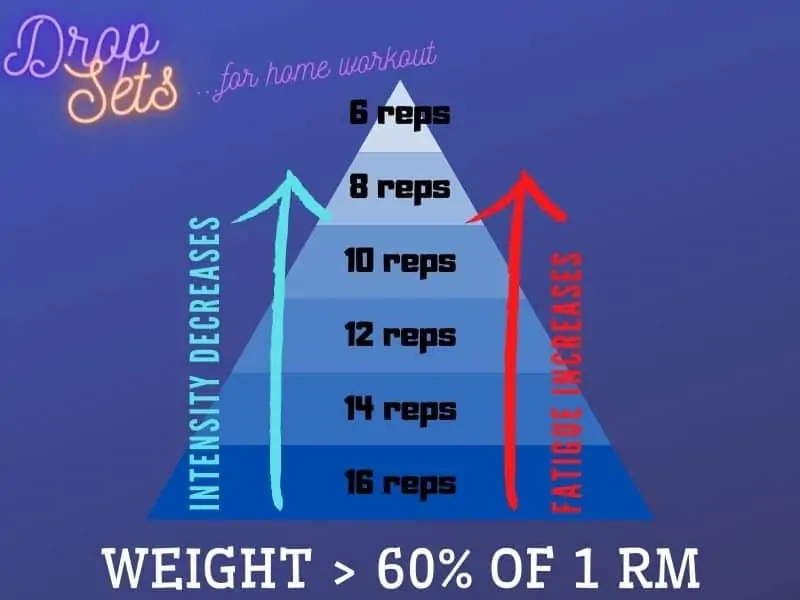How to pack on muscle if you only have 1 tool? Use modified drop sets.
Many people are obsessed with progressive overload. They are in the misbelief that if they don’t increase some training factor every subsequent workout their gains will halt, their body will all of a sudden get accustomed to the training stimulus and no longer adapt.

Well, if pushing a wheelbarrow full of liquid concrete felt heavy, do you think the next time it won’t be challenging just because it’s the same amount of concrete? The good news is, it takes much longer to reach an adaptation level where anabolic signals halt. Strength gains unfortunately don’t occur this fast.
That’s not to say that increasing intensity every session will not result in faster strength gains. Nor that you don’t need progressive overload in the long term. But just because you are not going on the fastest path doesn’t mean there are no anabolic processes triggered. Plus, linear periodization, adding weight or reps every session, leads to strength plateaus very quickly.

Dwelling at a certain level of intensity, having to train with the same weight for longer periods has its own benefits. It gives your tendons a chance to catch up with sudden muscle strength, that way you’ll stay more resilient to injuries. The same goes for your skill and coordination. The heavier the weights you are using the less you can coordinate your movement mechanics because your body will tense up and become clumsy.
There’s nothing new in this for those in the kettlebell world. You buy your first kettlebell and use it for years before feeling ready to move up a level. If you are not chasing strength and frequent training plan changes, it’s safest to first build work capacity on a certain level of intensity = the weight you are using. Look at it as an opportunity to solidify gains, and widen the base of your specific skill.

And that comes practical because beginner home gyms usually lack a wide selection of equipment. Modified drop sets are great to increase volume with a given weight, with what we have, and to be able to sustain a level of effort for longer while intensity is constant.
Using traditional drop sets is a way to add more repetitions and that way increase muscle fatigue with no rest between mini-sets. After your last rep, you immediately decrease the weight and continue to perform as many reps as you can, then decrease the weight again and continue this way until your muscles fry. In this fashion, you manipulate the weight, while repetitions stay constant to some extent.

With drop sets tailored to a fixed weight, it’s the opposite. You can’t manipulate the weight, but only the repetitions. Gradually downsize volume from the highest repetition set to the lowest one. Start out anywhere from 15-20 reps in the first set, then drop the reps each set by 1, 2, or 3, to the number where it still makes sense to do a set. (As you near towards the last sets with the lowest reps, obviously the exercise becomes lighter, even if you become more and more tired. That’s because that 62 pound is far from your one-rep max, in other words, if you could squat 20 with 62 pounds, you can always squat 1, like, forever, even when tired. So it doesn’t make sense to go all the way down to the 1 or 2 reps, though of course, you could.)
Also, if you start out with higher reps, around twenty, it makes sense to drop more reps/set. Unless you want to go from 20-1 by 1 increment and really squeeze out 20 sets.
This type of diminishing reps pyramid training not only allows you to sustain a level of voluntary effort, but it is easier psychologically to anticipate the next set.
Also, it doesn’t leave you trashed for days because as your fatigue sets in and your heart rate go up, the volume decreases to counterbalance.
For best results, use complex exercises, such as a back squat, deadlift, lunges, pushup, dip, jump squats, or even shuttle sprints, and no less than about 60-65% of 1 rep max intensity. This way as you get to the lower rep sets, there’s still enough muscle tension to elicit a reasonable training effect.
For visual purposes here’s how such a workout looks like starting from 16 reps:

Don’t rest too long between sets, the diminishing volume (hence diminishing intensity) in repetitions should counterbalance fatigue. Rest around a minute when you’re above 10 reps, and less than a minute when nearing the lower repetitions.
A similar method, or rather a progression to this home workout-modified drop set would be an EMOM (every minute on the minute) workout. With EMOM the weight and the repetition both remain constant and you do 1 set every minute. The rest time naturally decreases as the level of fatigue increases because it will take longer and longer to finish a set, and you’ll have less time before starting again on the minute.
